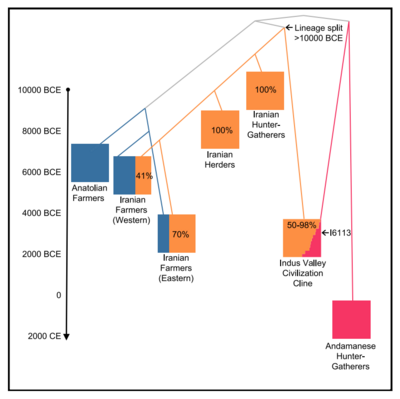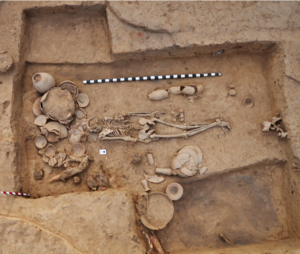Indus Valley DNA

In 2019, for the first time several ancient DNA samples related to the people of Indus-Saraswati Civilisation were published. Shinde et al 2019 published the only bronze age DNA samples found in India. This DNA sample was extracted from a skeleton found at archaeological site of Rakhigarhi located in the ancient Saraswati river plains. It was dated to ~2500 BCE and the skeleton belonged to a woman. Narasimhan et al 2019 published hundreds of DNA samples along with thirteen samples belonging to Indus valley migrants found in the Turan region which includes modern day Iran and Turkmenistan regions. These DNA samples were dated variously between 3300 to 2000 BCE and changed our understanding of the modern Indian population.
The Iranian related component that was once hypothesised to have arrived in India along with farming has turned out to be much more ancient. As the Shinde et al 2019 paper says, "Iranian-related ancestry in South Asia split from Iranian plateau lineages >12,000 years ago", implying that the people of Indus Valley and ancient Iranians had a common ancestor who lived more than 12,000 years ago. The IVC's Iranian related ancestry itself contains ~10% WSHG ancestry, which is the Western Siberian Hunter-Gatherer ancestry. This discovery lead the scientists to make the conclusion that farming is indigenous to the Indian subcontinent and was not brought in from the western first farmers of Anatolia.
Narasimhan paper shows the Out of India migration of Harappans into Iran and into Central Asia. ~50% of the total samples DNA samples found at the Iranian site of Shahr-i-sokhta belongs to the Harappan migrants and the locals of Shahr-i-sokhta also derive ~20% of ancestry from the Harappans. Narasimhan paper also find out the main population of BMAC harboured up to 5% ancestry related (deeply in time) to Andemanese hunter-gatherers (AHG). This provides evidence of gene flow from South Asia to Iran and Central Asia. Narasimhan paper finds out that BMAC is not the source of ancestry to the modern South Asians instead South Asia is the source of ancestry to BMAC main population. This disproved the earlier claim made by Damgard et al 2018 which proposed BMAC to be a source of modern South Asian based on only two ancient DNA samples from BMAC and none from South Asia where as Narasimhan et al 2019 published 86 ancient DNA samples from BMAC to show Out of India migration into BMAC.
IVC cline
Indus Valley DNA is characterised by the combination of one DNA sample found at Rakhigarhi published by Shinde et al 2019 and 11 Indus periphery cline DNA samples extracted from the skeletons found at archaeological sites in Iran and Turkmenistan region where they are identified as outliers published in Narasimhan et al 2019. The excessive AHG related ancestry in those 11 samples had indicated that those samples could belong to the migrants from the IVC. These 12 samples together are referred as IVC cline samples.
The authors of Shinde et al says,
"While our study is sufficient to demonstrate that this ancestry profile was a common feature of the IVC, a single sample—or even the gradient of 12 likely IVC samples we have identified cannot fully characterise a cosmopolitan ancient civilisation. An important direction for future work will be to carry out ancient DNA analysis of additional individuals across the IVC range to obtain a quantitative understanding of how the ancestry of IVC people was distributed and to characterise other features of its population structure."
IVC cline is derived distally as AHG-, WSHG- and Iranian- related groups where IVC's Iranian related ancestry splits from the Iranian plateau lineages more than 12,000 years ago.
| Sample ID | Location | Radiocarbon age | Sex | mtDNA
haplogroup |
Y chromosome
haplogroup | |
|---|---|---|---|---|---|---|
| 1 | I8726 | Shahr-i Sokhta, Iran | 3100-3000 BCE | M | U2c1 | J2a1h |
| 2 | I11480 | Shahr-i Sokhta, Iran | 2900-2800 BCE | M | W6 | J |
| 3 | I11459 | Shahr-i Sokhta, Iran | 2875-2631 calBCE | M | W3a1b | H1a1d2 |
| 4 | I11460 (Low-coverage) | Shahr-i Sokhta, Iran | 3200-2100 BCE | M | H2a | BT |
| 5 | I11458 | Shahr-i Sokhta, Iran | 3200-2100 BCE | M | .. | F |
| 6 | I8728 | Shahr-i Sokhta, Iran | 2600-2500 BCE | M | R7 | J2a |
| 7 | I10409 | Gonur, Turkmenistan | 2280-2044 calBCE | M | R5a2b | H1a1d2 |
| 8 | I11041 | Gonur, Turkmenistan | 2140-1972 calBCE | M | R2 | R |
| 9 | I11471 | Shahr-i Sokhta, Iran | 3328-3022 calBCE | F | U1a1c1 | n/a (female) |
| 10 | I11456 | Shahr-i Sokhta, Iran | 2600-2500 BCE | F | W3a1b | n/a (female) |
| 11 | I11488 (Low-coverage) | Shahr-i Sokhta, Iran | 3200-2100 BCE | F | R | n/a (female) |
| 12 | I11466 | Shahr-i Sokhta, Iran | 2500-2000 BCE | F | M30b | n/a (female) |
| 13 | I2123 | Gonur, Turkmenistan | 2452-2140 calBCE | F | .. | n/a (female) |
| 14 | I6113 | Rakhigarhi, India | 2500 BCE | F | U2b2 | n/a (female) |
Rakhigarhi DNA
Rakhigarhi is a village in Hisar district in the state of Harayana in India. Rakhigarhi is now the largest site of the Indus-Saraswati Civilisation popularly known as Indus Valley Civilisation. For the first time the scientists were able to successfully extract DNA sample from bronze archaeological sites of Indus Valley Civilisation. The scientists attempted to generate genome-wide data from skeletal remains of 61 individuals from Rakhigarhi. But only a single sample yielded enough authentic ancient DNA for analysis, that sample is named I6113. The reason for this scarcity of ancient DNA samples available from Indian subcontinent is the tropical weather of India which has caused contamination to the ancient skeletons thus rendering the DNA samples useless for analysis. Despite of hundreds of excavated skeletons from the bronze age sites of IVC, so far the scientists have only been able to extract one low coverage samples from Rakhigarhi. The skeletal samples from Rakhigarhi were excavated by the archaeological team led by Dr. Vasant Shinde at the Deccan College Post-Graduate and Research Institute in Pune India and sampled by the ancient DNA group led by Dr. Niraj Rai at the Birbal Sahni Institute of Palaeosciences in Lucknow India.
Rakhigarhi DNA analysis
The analysis of the DNA has changed the understanding of the modern Indian population and also helped understanding the genetic make up of the people that created the metropolitan cities of the Indus-Saraswati Civilisation, the advancement of which are incomparable to rest of the contemporary world. The scientists identified Rakhigarhi skeleton with that of a female and determined that its mitochondrial haplogroup is U2b2, which is absent in whole mitochondrial genomes sequences available from about 400 ancient Central Asians; today, this specific haplogroup is nearly exclusive to South Asia. The major observation made by the scientists using the DNA analysis are
- The IVC ancestry is the major source of ancestry for the modern South Asian population.
- The IVC and ancient Iranians come from a common ancestry who lived more than 12,000 years ago.
- Farming is indigenous to the Indian subcontinent and developed by local foragers.
- The Iranian-related or the Indian neolithic ancestry is the major source of ancestry (~80%) for the IVC people.
- The IVC population has no ancestry from Central Asian populations.
- Anatolian or Iranians farmer do not contribute to the IVC genome.
Indus Periphery Cline
Indus periphery cline is the name given to the 11 ancient DNA samples published in the Narasimhan et al 2019. Paper documented 11 outliers - three with radiocarbon dates between 2500 and 2000 BCE from the BMAC site of Gonur in Turkmenistan and eight with radiocarbon dates between 3300 and 2000 BCE from the Iranian site of Shahr-i-Sokhta. These outliers harboured elevated levels of AHG-related ancestry with a major component of ancestry being the Indian neolithic ancestry that shares a common ancestor with the ancient Iranians who lived more than 12,000 years ago. The table contains two low coverage samples - I11460 and I11488 along with 11 Indus Periphery cline samples and Rakhigarhi sample.
Indus Periphery samples are labeled as as Shahr-i-Sokhta_BA2 and Gonur2_BA. Shahr-i-Sokhta_BA2 samples form ~50% of the samples found at archaeological site of Shahr-i-Sokhta, Iran, which shows a significant migration from IVC to Iran.
Out of India migration
Narasimhan paper shows Out of India migration from South Asia to Iran and Central Asia.
Narasimhan et al 2019 supplementary report, Table S30 provides a proximal model for the Shahr-i-Sokhta_BA1, dated 3100 to 2600 BCE, derives 20% of their ancestry from the Harappans (Shahr-i-Sokhta_BA2). Several proximal models are provided in the paper, each with Indus periphery cline as source peaking up to ~23% in one of the proximal model. About 1,000 graves have been excavated at Shahr-i-Sokhta and the archaeologists finds
"Extraordinary conservation of organic materials, as well as early evidence of long-distance contacts with southern Central Asia, Afghanistan (especially trade in lapis lazuli) and Baluchistan in South Asia are its main archaeological features."
A total of 17 DNA samples were extracted from Shahr-i-Sokhta out of which 8 samples which is ~50% of the samples belonged to the Harappan migrants to Shahr-i-Sokhta. The Shahr-i-sokhta individuals, labelled Shahr-i-sokhta_BA1 are dated from 3100 BCE to 2600 BCE where the Harappan migrants (Shahr-i-sokhta_BA2) are dated from 3300 BCE to 2000 BCE. Narasimhan et 2019 supplementary reports says
"The archaeological and genetic evidence thus suggest that a flow of migrants from the northwestern borderlands of South Asia was active at the beginning of the local settlement, and that the same flow, different from the earlier one from northwest, intensified in the following centuries. We unfortunately do not have ancient DNA from Period III and the later centuries of the Shahr-i-Sokhta sequence when cultural influence from the Indus Valley Civilization appears to become stronger"
The migration from Indus Valley Civilisation to Iran starts in the later half of 4th millennium BCE then continues through third millennium BCE which appears to become stronger genetically and archaeologically towards the end of third millennium BCE but unfortunately there are no ancient DNA available yet to from the following period III from Shahr-i-sokhta, Iran.
